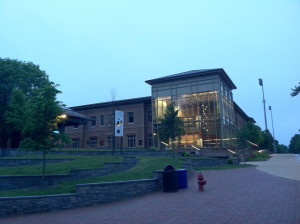Members of the Student Environmental Action Coalition organized a panel March 22 to discuss their Seize the Grid campaign to convert the College of William and Mary to 100 percent renewable energy by 2030. The panel focused on the financial challenges of such a transition, along with difficulties in getting the College administration to act and the consequences of the expanding need for energy
The three-person panel included biology professor and Director of the Keck Environmental Lab Randy Chambers, College’s Committee on Sustainability intern Jason Zhang ’18 and local activist Betsy Shepard, who was invited to provide a perspective on the effects of energy needs on the wider community. According to moderator Anne Davis ’16, Seize the Grid members wrote most of the prepared questions. At the end of the event, students in the audience were invited to ask questions.
Chambers and Zhang focused mainly on the obstacles facing Seize the Grid, including a lack of motivation on the part of the administration due to the costs of converting to solar power and the relatively cheap prices of the College’s current energy supplier, Dominion Virginia Power.
“It kind of makes sense that William and Mary isn’t pushing for solar as hard as some other colleges in some other states because we are currently getting electricity for so cheap,” Zhang said.
It kind of makes sense that William and Mary isn’t pushing for solar as hard as some other colleges in some other states because we are currently getting electricity for so cheap,” Zhang said.
Shepard, a resident of Surry County where Dominion operates a nuclear power plant, talked about her experiences living near a nuclear facility and her successful campaign against the building of a coal-fired power plant in her community.
“We have this stuff sitting in our community,” Shepard said. “I think it’s really useful when we’re thinking about how much we pay for these things to think about what those other ramifications are. And if you had to choose to have that stuff stored on your campus, how much extra would you pay to have something else like solar?”
We have this stuff sitting in our community. I think it’s really useful when we’re thinking about how much we pay for these things to think about what those other ramifications are. And if you had to choose to have that stuff stored on your campus, how much extra would you pay to have something else like solar?” Shepard said.
Seize the Grid member Leah Marshall ’19 estimated that around a third of the audience was made up of fellow members of the campaign, while the rest were either other SEAC members or students who were coming for the first time. One of these newcomers was Chinmay Dasari ’19, who became interested in Seize the Grid after seeing the solar charging table installed on the Sadler Center Terrace.
“I just wanted to figure out what they’re doing because I have no idea and this was a perfect opportunity for that,” Dasari said. “I learned a lot about solar energy feasibility, the opinions of the administration as to how we need to pitch it towards them . . . and a lot of the social justice issues that are related to solar energy.”
Furthering its community reach, Seize the Grid invited students to sign a petition addressed to College President Taylor Reveley and to attend weekly SEAC meetings.

